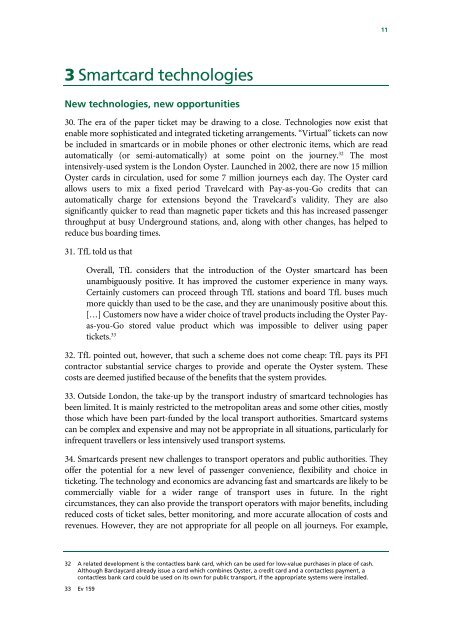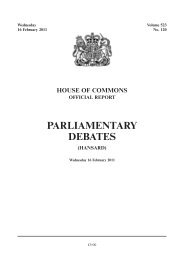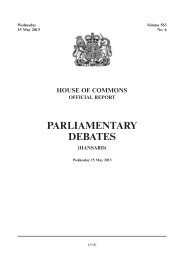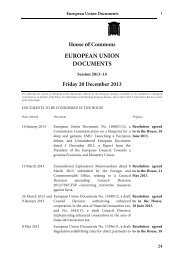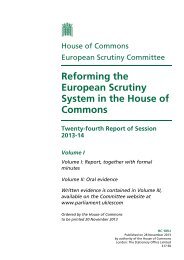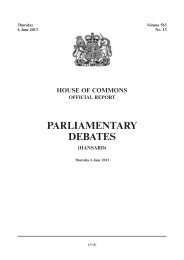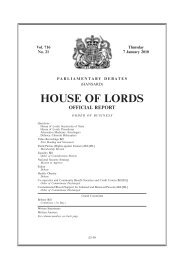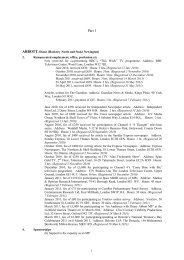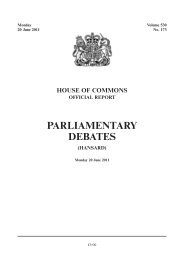Ticketing and Concessionary Travel on Public Transport - United ...
Ticketing and Concessionary Travel on Public Transport - United ...
Ticketing and Concessionary Travel on Public Transport - United ...
Create successful ePaper yourself
Turn your PDF publications into a flip-book with our unique Google optimized e-Paper software.
3 Smartcard technologies<br />
New technologies, new opportunities<br />
30. The era of the paper ticket may be drawing to a close. Technologies now exist that<br />
enable more sophisticated <str<strong>on</strong>g>and</str<strong>on</strong>g> integrated ticketing arrangements. “Virtual” tickets can now<br />
be included in smartcards or in mobile ph<strong>on</strong>es or other electr<strong>on</strong>ic items, which are read<br />
automatically (or semi-automatically) at some point <strong>on</strong> the journey. 32 The most<br />
intensively-used system is the L<strong>on</strong>d<strong>on</strong> Oyster. Launched in 2002, there are now 15 milli<strong>on</strong><br />
Oyster cards in circulati<strong>on</strong>, used for some 7 milli<strong>on</strong> journeys each day. The Oyster card<br />
allows users to mix a fixed period <str<strong>on</strong>g>Travel</str<strong>on</strong>g>card with Pay-as-you-Go credits that can<br />
automatically charge for extensi<strong>on</strong>s bey<strong>on</strong>d the <str<strong>on</strong>g>Travel</str<strong>on</strong>g>card’s validity. They are also<br />
significantly quicker to read than magnetic paper tickets <str<strong>on</strong>g>and</str<strong>on</strong>g> this has increased passenger<br />
throughput at busy Underground stati<strong>on</strong>s, <str<strong>on</strong>g>and</str<strong>on</strong>g>, al<strong>on</strong>g with other changes, has helped to<br />
reduce bus boarding times.<br />
31. TfL told us that<br />
Overall, TfL c<strong>on</strong>siders that the introducti<strong>on</strong> of the Oyster smartcard has been<br />
unambiguously positive. It has improved the customer experience in many ways.<br />
Certainly customers can proceed through TfL stati<strong>on</strong>s <str<strong>on</strong>g>and</str<strong>on</strong>g> board TfL buses much<br />
more quickly than used to be the case, <str<strong>on</strong>g>and</str<strong>on</strong>g> they are unanimously positive about this.<br />
[…] Customers now have a wider choice of travel products including the Oyster Payas-you-Go<br />
stored value product which was impossible to deliver using paper<br />
tickets. 33<br />
32. TfL pointed out, however, that such a scheme does not come cheap: TfL pays its PFI<br />
c<strong>on</strong>tractor substantial service charges to provide <str<strong>on</strong>g>and</str<strong>on</strong>g> operate the Oyster system. These<br />
costs are deemed justified because of the benefits that the system provides.<br />
33. Outside L<strong>on</strong>d<strong>on</strong>, the take-up by the transport industry of smartcard technologies has<br />
been limited. It is mainly restricted to the metropolitan areas <str<strong>on</strong>g>and</str<strong>on</strong>g> some other cities, mostly<br />
those which have been part-funded by the local transport authorities. Smartcard systems<br />
can be complex <str<strong>on</strong>g>and</str<strong>on</strong>g> expensive <str<strong>on</strong>g>and</str<strong>on</strong>g> may not be appropriate in all situati<strong>on</strong>s, particularly for<br />
infrequent travellers or less intensively used transport systems.<br />
34. Smartcards present new challenges to transport operators <str<strong>on</strong>g>and</str<strong>on</strong>g> public authorities. They<br />
offer the potential for a new level of passenger c<strong>on</strong>venience, flexibility <str<strong>on</strong>g>and</str<strong>on</strong>g> choice in<br />
ticketing. The technology <str<strong>on</strong>g>and</str<strong>on</strong>g> ec<strong>on</strong>omics are advancing fast <str<strong>on</strong>g>and</str<strong>on</strong>g> smartcards are likely to be<br />
commercially viable for a wider range of transport uses in future. In the right<br />
circumstances, they can also provide the transport operators with major benefits, including<br />
reduced costs of ticket sales, better m<strong>on</strong>itoring, <str<strong>on</strong>g>and</str<strong>on</strong>g> more accurate allocati<strong>on</strong> of costs <str<strong>on</strong>g>and</str<strong>on</strong>g><br />
revenues. However, they are not appropriate for all people <strong>on</strong> all journeys. For example,<br />
32 A related development is the c<strong>on</strong>tactless bank card, which can be used for low-value purchases in place of cash.<br />
Although Barclaycard already issue a card which combines Oyster, a credit card <str<strong>on</strong>g>and</str<strong>on</strong>g> a c<strong>on</strong>tactless payment, a<br />
c<strong>on</strong>tactless bank card could be used <strong>on</strong> its own for public transport, if the appropriate systems were installed.<br />
33 Ev 159<br />
11


